 I thought I would get through this pandemic and never write about it. After all, it’s all you hear about, and I am a bit sick of hearing about it. But I woke up this morning at 3 am, and I was horrified to find that I was writing about the pandemic in my mind. I lay there, wanting to go back to sleep, but I kept thinking of what I would say.
I thought I would get through this pandemic and never write about it. After all, it’s all you hear about, and I am a bit sick of hearing about it. But I woke up this morning at 3 am, and I was horrified to find that I was writing about the pandemic in my mind. I lay there, wanting to go back to sleep, but I kept thinking of what I would say.
So here I am at 3:24 doing what I have been avoiding. One reason I wouldn’t write about it is that as hard as I have tried, I haven’t been able to come up with a word for how I feel. I was sitting at my desk yesterday trying to describe how I felt to an old friend. I’m not afraid or worried. I’m not angry. I’m not even bored. Quite the opposite. I feel inundated, at times, with all that must be managed in a house of nine people, that span four different generations – and no one can leave!
But there is a feeling that I can’t name. I’ve been giving this considerable thought because I want a word for it. I feel the need to name it.
Is it a lack of freedom?
Although many things have changed, I can still get in the car clothed in rubber gloves and mask and pick up food or medication. If we get stir crazy, even though public places are closed, we can drive around the lake or visit the mountains, as long as the ride isn’t too long, and we don’t need a bathroom.
Is it a lack of choice?
When I got up a couple of mornings ago, I asked myself, “What would you like for breakfast.” Into my mind came several ideas about what I could eat. It felt pleasurable deciding. And the night before, as I got into the shower, I remembered thinking, “How do I feel tonight. Do I want a warm shower or a hot one?” These two events had me journaling about the huge array of choices I have every day and how wonderful it is to choose. Even now, when things are restricted, I have room for choice.
Is it the change in routine?
That has certainly happened to me. I’m self-employed. I care for people and their homes, most of them old. I run errands, work in the yard and clean. I’ve been doing this for over a decade. My clients have become my friends.
Now my focus has shifted to home – our yard, our house, our needs. But aside from not making the significant drive to Salt Lake City not much is different. I still get up early. I still care for the needs of many people, and if I include myself, three of them are old. LOL
So, what is it, this unnamed feeling
that unsettles me, that sits on my shoulders like a heaviness, but not fear? A couple of days ago I read a post that a friend sent to me and I think it speaks to the unnamed feeling I have been trying to decipher.
As far as I could discover it was written by Sherrie Eichmeier Reynolds and posted on a Facebook page titled Worldwide Inspiration. I have included some comments by readers in parenthesis, have shortened places and made some slight changes. It concerns the Bible and the number 40 and some beautiful sentiments on Christ. But I’m not sharing it for religious reasons. I’m sharing it because it speaks to the unnamed feeling I have. You can read the whole thing as written HERE.
“The Latin root of the word “quarantine” is “forty.” What does the Bible say about 40?
“The flood lasted 40 days. For 40 years Moses fled Egypt. For 40 days Moses stayed on Mount Sinai to receive the Commandments. The Exodus lasted 40 years. Jesus fasted for 40 days. Lent is 40 days. There were a required 40 days for a woman to rest after giving birth. (In the old days, when ships arrived from foreign lands if there were any sick passengers aboard, the whole ship was placed on quarantine -40 days- to make sure they weren’t going to spread anything to the local population.)
“A group of theologians thinks the number 40 represents “change.” It is the time of preparing a person, or people, to make a fundamental change.”
And there it is, the name for what I have been feeling – uncertainty and change.
When this is all over, I will be different. My neighbors will be different. My state, my country, and the world will be different. We will be changed. The future is uncertain. My next move is uncertain.
I moved a lot as a kid and it always left me feeling uncertain. But as I consider uncertainty from the distance of seven decades, I see how this word and the attendant feelings have propelled me forward. It has moved me to new ways of being and understanding as I grappled with what I didn’t yet know.
I am confident that in the end, it will have been good, and I will have grown. I am confident because I have learned to sit with the discomfort of uncertainty. You have probably heard some version of this – the only certainty is uncertainty. It’s a reality, and it helps us grow.
I won’t bother to tell you how to sit with uncertainty. There are a plethora of articles online. Just know that in seven decades I have lived through many uncertain times, some far more frightening than this. During this one, I’ve been re-evaluating. I’ve been making some adjustments in how I think, work, study, read, and spend my time. I know I have been growing.
So, for now, I’m going to sit comfortably at this time of uncertainty, and I hope it will be the same for you.
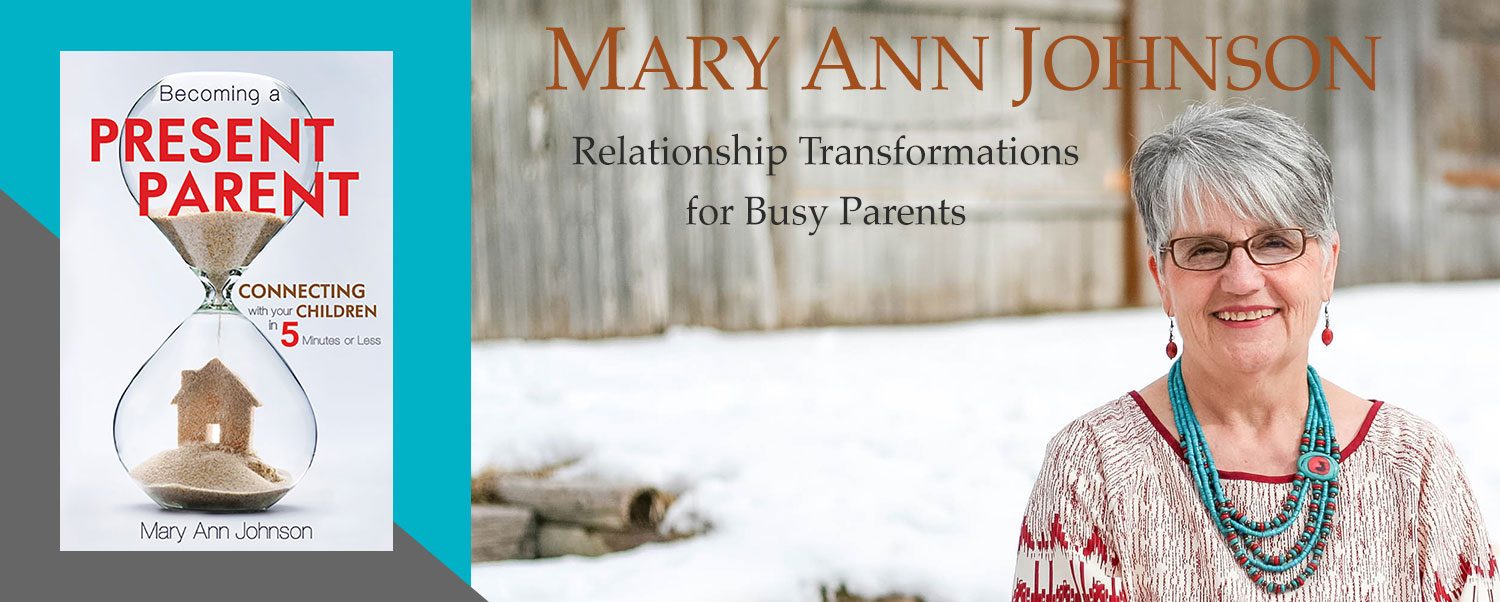

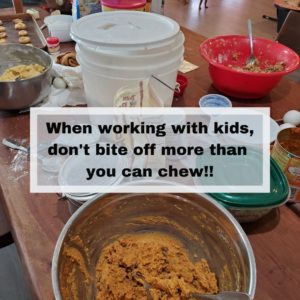 Keep It Simple
Keep It Simple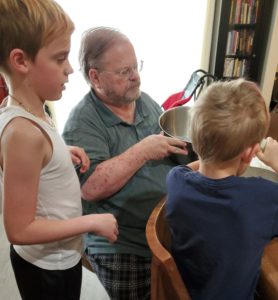 reasoned that he could help the two boys, one 12 and one 6. The 12-year-old wouldn’t need much help. I would help the girls, one 10 and one 14, with special needs. The 10-year-old is creative and fairly independent. That should work out alright.
reasoned that he could help the two boys, one 12 and one 6. The 12-year-old wouldn’t need much help. I would help the girls, one 10 and one 14, with special needs. The 10-year-old is creative and fairly independent. That should work out alright.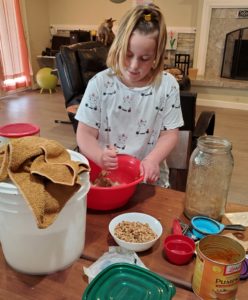 NOT! Don couldn’t manage two at a time and was totally involved with the six-year-old. That left me with three. As for the twelve-year-old, I discovered that when it comes to cooking, he needed a lot of help. And as far as the 10-year-old goes, she couldn’t read my cursive. Of course, her recipe card was in my cursive. Sigh. It was like trying to wrangle chickens. You’ve never done that. Well, trust me, it’s tiring!! And here is another thing. I am perfectly aware that expectations can do a good project in. I teach that. I am an expert.
NOT! Don couldn’t manage two at a time and was totally involved with the six-year-old. That left me with three. As for the twelve-year-old, I discovered that when it comes to cooking, he needed a lot of help. And as far as the 10-year-old goes, she couldn’t read my cursive. Of course, her recipe card was in my cursive. Sigh. It was like trying to wrangle chickens. You’ve never done that. Well, trust me, it’s tiring!! And here is another thing. I am perfectly aware that expectations can do a good project in. I teach that. I am an expert.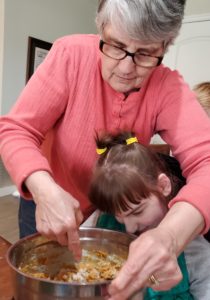 cream the sugar and shortening, no problem. Then they will cook their cookies, we will eat some and each will clean up their spot on the table. WHAT WAS I THINKING!!!
cream the sugar and shortening, no problem. Then they will cook their cookies, we will eat some and each will clean up their spot on the table. WHAT WAS I THINKING!!!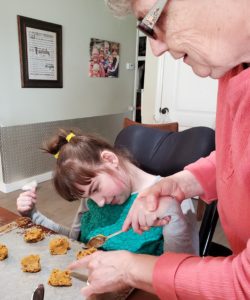 I have to say, that
I have to say, that 
 “A 92-year-old, petite, well-poised and proud man, who is fully dressed each morning by eight o’clock, with his hair fashionably combed and shaved perfectly, even though he is legally blind, moved to a nursing home today. His wife of 70 years recently passed away, making the move necessary. After many hours of waiting patiently in the lobby of the nursing home, he smiled sweetly when told his room was ready.
“A 92-year-old, petite, well-poised and proud man, who is fully dressed each morning by eight o’clock, with his hair fashionably combed and shaved perfectly, even though he is legally blind, moved to a nursing home today. His wife of 70 years recently passed away, making the move necessary. After many hours of waiting patiently in the lobby of the nursing home, he smiled sweetly when told his room was ready.
 I have a friend who has a tiny poodle named Isadore. When I last visited her, she complained that he is spoiled rotten. He wants to be held all the time. She said Isadore drips water from his chin when he drinks and so the floor is always a mess. She sighed in exasperation.
I have a friend who has a tiny poodle named Isadore. When I last visited her, she complained that he is spoiled rotten. He wants to be held all the time. She said Isadore drips water from his chin when he drinks and so the floor is always a mess. She sighed in exasperation.
 When my grandson, Jack, was three, Mary was just one and Maggie was five, I taught them about germs and hygiene. It was chaotic. Mary was on the table and into everything. Jack wanted his way. Maggie, of course, needs LOTS of help. Whew. Did they get any of that? Despite all my preparation and planning, I was sure that the whole thing had been a big fat flop!
When my grandson, Jack, was three, Mary was just one and Maggie was five, I taught them about germs and hygiene. It was chaotic. Mary was on the table and into everything. Jack wanted his way. Maggie, of course, needs LOTS of help. Whew. Did they get any of that? Despite all my preparation and planning, I was sure that the whole thing had been a big fat flop!


 Recently, I was having a conversation with a friend about connecting daily with children. I mentioned that random touch was one of the most powerful practices I knew for connecting multiple times a day.
Recently, I was having a conversation with a friend about connecting daily with children. I mentioned that random touch was one of the most powerful practices I knew for connecting multiple times a day.

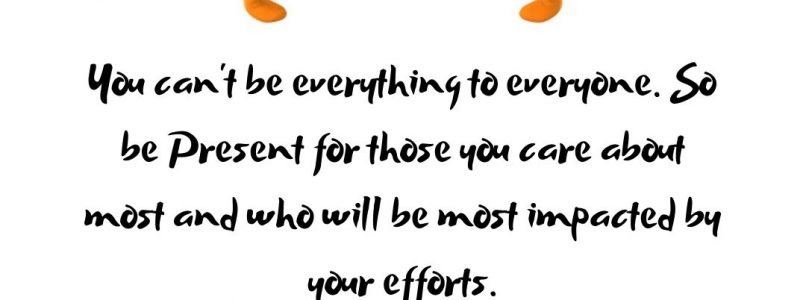
 I saw an insurance commercial in which the adults (portrayed by kids) were being treated like children by the insurance company. They felt helpless, undervalued, and frustrated. When I saw this commercial, I, like most of you, could relate to those feelings. At the end of the commercial, a rival insurance company helped a woman (portrayed by a child) with her needs. She stood there smiling, feeling good.
I saw an insurance commercial in which the adults (portrayed by kids) were being treated like children by the insurance company. They felt helpless, undervalued, and frustrated. When I saw this commercial, I, like most of you, could relate to those feelings. At the end of the commercial, a rival insurance company helped a woman (portrayed by a child) with her needs. She stood there smiling, feeling good. of my relaxing and fun things to-do list. I was feeling some pressure. My 3-year-old daughter, Marie, kept coming into the sewing room and interrupting me. This and the sewing were wearing on my nerves. I was ready to spank her. After all, she was bugging me, and she could see perfectly well that I was busy! I decided if she interrupted me again, I was going to swat her.
of my relaxing and fun things to-do list. I was feeling some pressure. My 3-year-old daughter, Marie, kept coming into the sewing room and interrupting me. This and the sewing were wearing on my nerves. I was ready to spank her. After all, she was bugging me, and she could see perfectly well that I was busy! I decided if she interrupted me again, I was going to swat her.
 The windows are fog-covered from soup steam and the air smells of baking bread. It’s cold outside on this wintry Montana day. I hear the children clattering through the gate and up the back steps, coming home from school. “Don’t bang the screen door”.
The windows are fog-covered from soup steam and the air smells of baking bread. It’s cold outside on this wintry Montana day. I hear the children clattering through the gate and up the back steps, coming home from school. “Don’t bang the screen door”.